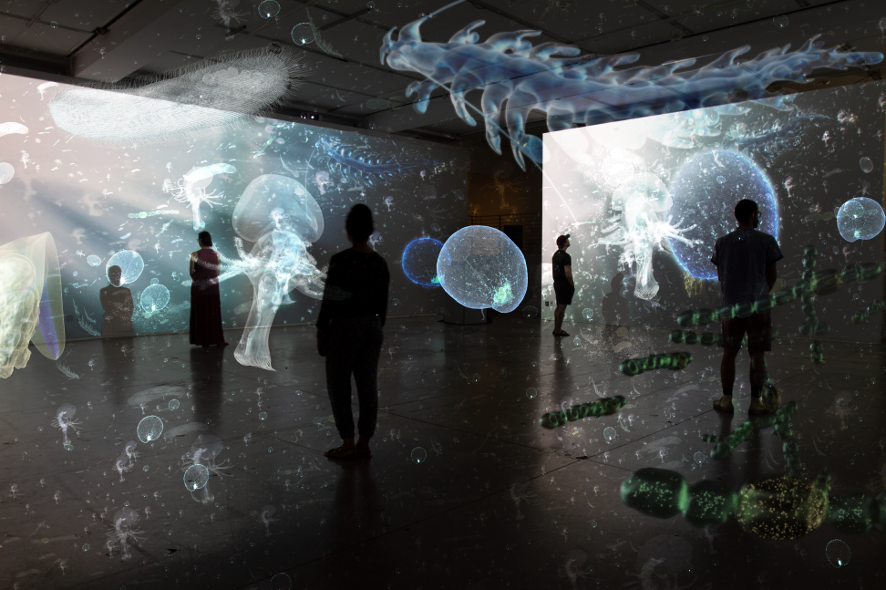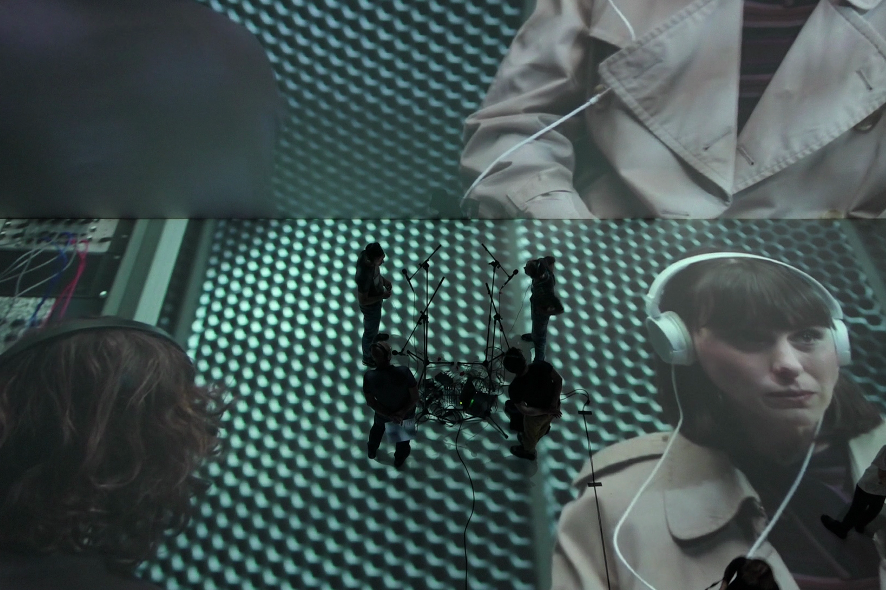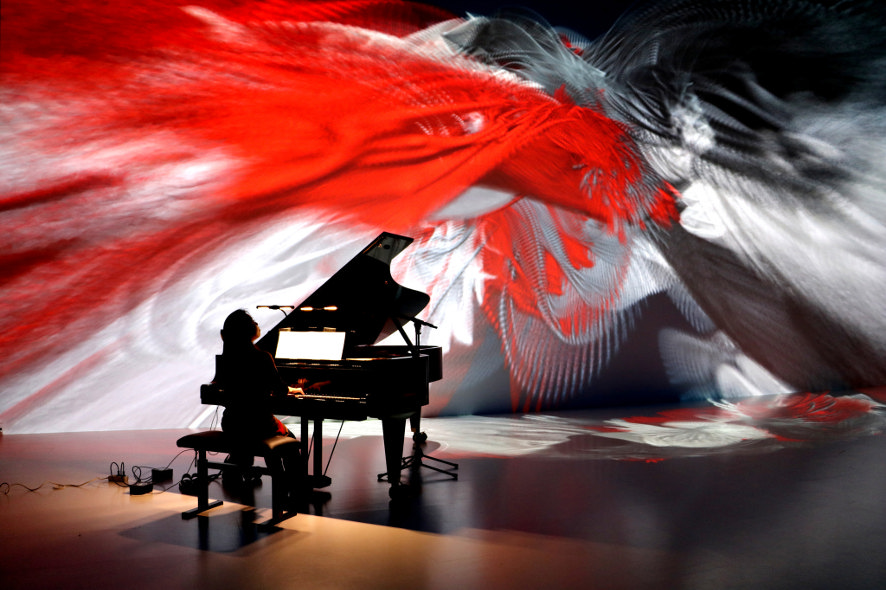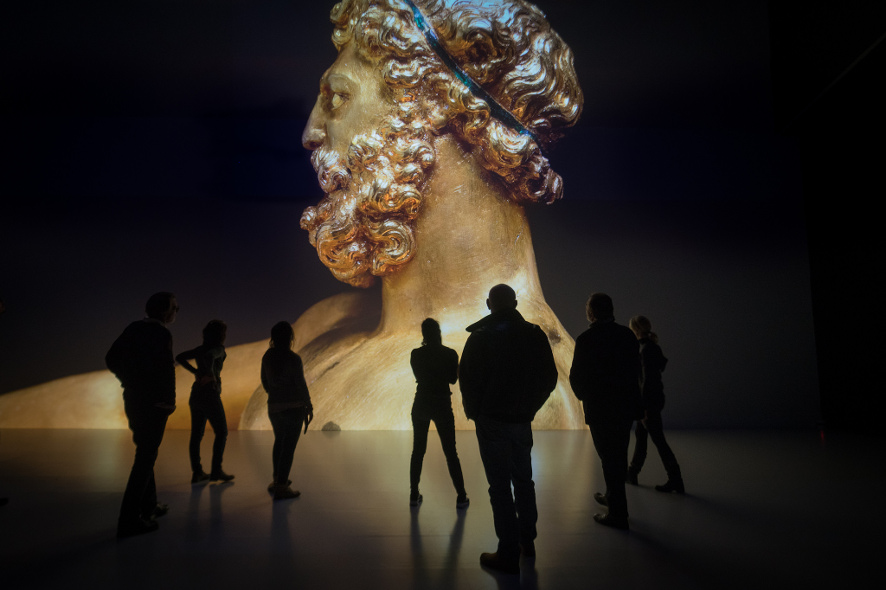Thanks to the 16 x 9 meter wall and floor projections, 8K resolution and technical refinements such as laser tracking and 3D animations, the Ars Electronica Center‘s Deep Space 8K offers impressive experiences and visual worlds. During the Ars Electronica Festival 2018, a number of artists will once again present their current works in person at Deep Space 8K. Michaela Obermayer, area manager of Deep Space 8K, told us in an interview what exactly awaits us on the five days.

Credit: Karina Lopez
Our motto is “Never call Deep Space 8K a movie theater!” The Deep Space program for the Ars Electronica Festival 2018, for example, uses laser tracking for some projects. Tell us more!
Michaela Obermayer: Festivalgoers will get to see four works that employ laser tracking—first off, projects subsumed under the title “Cooperative Aesthetics” that Linz Art University Professor Gerhard Funk and his students have been developing for several years now in Deep Space 8K. As the name suggests, “Cooperative Aesthetics” entails audience participation to produce a particular image on screen, and the better the spectators cooperate, the more interesting the visual design.
Another work that utilizes laser tracking is “City Lights” from the Upper Austria University of Applied Sciences’ Hagenberg Campus. Spectators are transported to 1920s Chicago, where a power failure has plunged the city into darkness and the audience has to position itself in Deep Space so as to turn the lights back on.
Victoria Vesna of UCLA is also presenting a new work based on laser tracking. “Noise Aquarium” immerses spectators into an ocean full of plankton that’s displayed on Deep Space 8K’s jumbo projection screen and reacts to visitors’ presence. This alludes to the fact that human beings’ mere presence has an impact on nature and our environment.
Another work with laser tracking is by Bandai Namco, the Japanese game developer whose creations include PACMAN. Their contribution to last year’s Ars Electronica Festival was “Fungage”—a portmanteau word made up of fun and language. With it, PACMAN, the on-screen omnivore that devours gaming objects, can be assigned various emoticons that express the player’s mood. An expanded form of “Fungage” will be presented this year.

House of Medusa, Credit: Hagenberg University of Applied Sciences
This time, there’ll even be a project that connects Deep Space 8K with Virtual Reality …
Michaela Obermayer: Right, the “House of Medusa” by Hagenberg University of Applied Sciences. We’ve been featuring this project for some time now in our VRLab, where it can be experienced on a VR headset. This is a beautiful work about archeology in Upper Austria, where a Roman villa near what is now the city of Enns was recently discovered and excavated. It featured lovely frescoes, though only fragments of them were recovered by the dig. In this VR application, the user tries to reassemble the images just like an archeologist. Of course, that works really well with a VR headset, but then only one person sees what’s going on in this virtual world. During the festival, we’ll be showing “House of Medusa” in Deep Space 8K. The audience assumes the point of view of the person wearing the headset and what the user sees is displayed on Deep Space’s jumbo projection wall.

Old News from New Friends, Credit: Resoluta
What other projects use Deep Space 8K in a particularly interesting way?
Michaela Obermayer: Deep Space 8K serves as a performance venue for “Old News from New Friends,” a collection of work by young artists at the Academy of Media Arts Cologne that premiered at a recent Deep Space LIVE event. The projects include classic videos, animated shorts, sound performances and works engendered via cooperation and/or interaction with visitors. This is a real audiovisual experience!
And there’s “GAPPP,” Marco Ciciliani’s project that deals with the sounds and noises made by old computer games and considers various possibilities of imparting a modern audiovisual style to them.

Prima Materia, Credit: Robert Bauernhansl
Deep Space 8K won’t only be showing works by artists invited to appear at the festival. The lineup also includes work by our colleagues on the staff of the Ars Electronica Futurelab. What’s on tap?
Michaela Obermayer: One is “Immersify,” a project produced under the aegis of Horizon 2020, an EU program for research and innovation. Thus, European collaboration on a large scale went into this project that’s all about how the boundaries of immersion can be expanded even further. I mean, being totally immersed in a virtual world calls for high-resolution images, ideally in 3D. At the festival, “Immersify” will feature ultra-high-resolution videos—for instance, a work by Los Angeles-based photographer Joe Capra, whose very impressive video about Rio has already been screened in Deep Space 8K at 10K resolution. And we’re particularly delighted that “Immersify” is making it possible an 8K reprise of “Prima Materia,” Nohlab’s superb work that we presented to festivalgoers in 2016.
The Ars Electronica Futurelab also works together with Japanese TV broadcaster NHK. They’ll be screening a series of high-resolution videos including one of Tokyo that’s of such high quality that even the minutest details of the cityscape are visible. We’ll also screen short videos by artists, ‘cause it’s always fascinating to see how they work with high-resolution capabilities.
As recently reported on the Ars Electronica Blog is “Creative AI – Style Transfer” a great project by our colleague Ali Nikrang. In it, he uses a technology that many of us are familiar with from smartphone apps—processing photos by applying the style of a famous artist to them. Ali Nikrang took this technique to the next level—applying it, frame by frame, to a video. Festivalgoers will behold our famous video of a downhill run on the Streif, Kitzbühel’s world-famous ski slope, in the styles of Wassily Kandinsky and Roy Lichtenstein. As far as we know, this is a world premiere—the first time this has ever been applied to a video. Ali will also give a talk about the nuts & bolts of this technique and show several other examples of it.

Maki Namekawa at the Ars Electronica Festival 2017, Credit: Magdalena Sick-Leitner
What are your personal highlights being shown in Deep Space 8K during this year’s festival?
Michaela Obermayer: One of my personal highlights is always the big live concert in Deep Space 8K. In 2017, world-famous pianist Maki Namekawa played Philip Glass’ “Twenty Etudes for Piano” to live visualizations by Cori O’Lan. This year, pianist Suyang Kim will perform live in Deep Space, and the accompanying visualizations will be provided by Ouchhh, a group of artists from Turkey who appeared at last year’s festival too.
Another superb video is by festival veteran Memo Akten, who’ll also be showing a couple of pieces in which he works with artificial intelligence.

Cellini’s Salt Cellar, Credit: Robert Baurnhansl
So, there’ll be a colorful mix in Deep Space 8K once again at this year’s festival …
Michaela Obermayer: Exactly! We’re trying our best to show each presentation at least once a day so that festivalgoers have an opportunity to catch as many of them as problem. Between screenings of works by individual artists, we’ll run our “Best of Deep Space 8K” program as well as one of our Deep Space classics, “Cultural Heritage.” Since this is European Year of Cultural Heritage and we have a lot of material about sites that are either off-limits to the general public or are accessible only at the end of a very long journey, we’ve decided to make this a part of the festival program. Plus, we’ll be featuring a Daily Selection showcasing the highlights of this year’s Deep Space 8K festival program.
The Deep Space 8K at the Ars Electronica Center will be open during the Ars Electronica Festival from September 6-10, 2018 from Thursday to Sunday from 10 AM to 8 PM and Monday from 10 AM to 6 PM.
To learn more about Ars Electronica, follow us on Facebook, Twitter, Instagram et al., subscribe to our newsletter, and check us out online at https://ars.electronica.art/news/en/.
